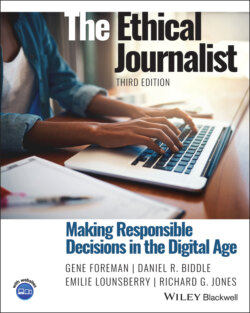Читать книгу The Ethical Journalist - Gene Foreman - Страница 55
Helping police catch a suspect
ОглавлениеWhen photographer Russ Dillingham of the Lewiston (Maine) Sun Journal heard on the police radio that officers had cornered a fugitive in an apartment building, he rushed to the scene. He watched from the ground while police searched the third floor. “I’ve been doing this a long time,” the 25‐year veteran said later. “I kind of figured he’d be where the cops weren’t.”
His calculation was correct. He started taking pictures as the fugitive, Norman Thompson, leaped from the building’s balcony onto a garage roof next door. From there, Thompson jumped to the ground – “like a cat,” Dillingham remembered later.
“Tackle him, Russ! Tackle him!” Detective Sergeant Adam Higgins called down.
Dropping his camera, Dillingham chased Thompson, tackled him, and held him down until the officers could catch up. Then he retrieved his camera and photographed Thompson as he was handcuffed and taken to jail on multiple charges of automobile theft and fleeing police in high‐speed car chases. Thompson was not armed, but Dillingham hadn’t known that when he made his tackle.
Police praised Dillingham, saying they could not have made the arrest without the photographer’s help. The Sun Journal’s executive editor, Rex Rhoades, also was effusive: “We’re all very proud of Russ. He’s a stud.”7
However, in a column in News Photographer, ethics scholar Paul Martin Lester raised questions about the 2007 incident, including: What if Dillingham had been severely injured? What if the suspect had been injured and sued Dillingham? What if the suspect was innocent? What happens the next time Dillingham is asked by police for help? What if a more dangerous suspect mistakes him for a cop? Lester noted that the ethics code of the National Press Photographers Association says photographers should not “intentionally contribute to, alter, or seek to alter or influence events.” He recommended that Dillingham and his colleagues meet with the police to make clear that tackling suspects is not something journalists will do in the future, and that officers should not take it personally when they refuse.8
Dillingham’s decision was instinctive. “In a split second, I made a decision to be a citizen, a community member, an American,” he said. “I did what I thought was right and would do it again in a heartbeat.”9 “You don’t even think about it,” Dillingham said. “You just react.” In his column Lester made it clear he wasn’t criticizing Dillingham but urging that journalists think in advance about how to respond to situations they might face, much as a baseball fielder anticipates what he will do if the ball is hit in his direction.10
Dillingham was not confronted with saving someone from death, injury, or suffering. Instead, the photographer was asked to help the police do their jobs. Lester made a case for saying no. Yet, refusing to tackle the suspect would have almost certainly subjected Dillingham and the journalism profession to scorn not only from the police but from the public as well. What kind of citizen would not stop someone fleeing from police officers, especially when the officers are asking him to do so?
Both the police and the journalists who cover them have important missions in the community, and sometimes those missions are in conflict. Such a conflict occurs when, after a riot, the police ask the news media to turn over photographs and videos that have not been published or broadcast. They want to use the images to identify and prosecute wrongdoers.
Philip Seib and Kathy Fitzpatrick framed this journalist’s dilemma in their book Journalism Ethics:
The “good citizen” response might be: “Sure; use our tapes. We’re not pro‐looter here. If we can help you lock up criminals, we’ll be glad to do so.” That reply sounds noble, but it contains a significant problem. Journalists were able to do their reporting after police had left the riot area because the rioters were angry with the police but not with the news media. If, however, the news gatherers turn out to have been evidence gatherers, the next time a similar event occurs the public may not treat police and reporters differently. The journalists might not be able to cover the event from the vantage points they previously enjoyed, and they may even find themselves in danger.11
In his book Don’t Shoot the Messenger, media lawyer Bruce W. Sanford wrote:
The media have long opposed these attempts to press them into service as a sort of litigation resource or video library for the prosecution or defense. Reporters fear that they seem to take sides when their testimony or work product becomes the subject of a trial. And when confidential sources are involved, compelling reporters to testify or to surrender their notes, video‐ or audiotapes may reveal identities and dry up important sources of information.12
